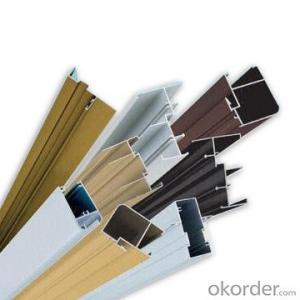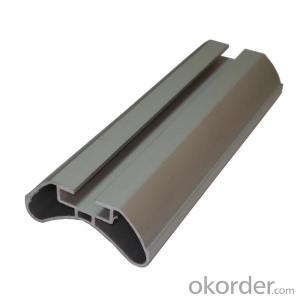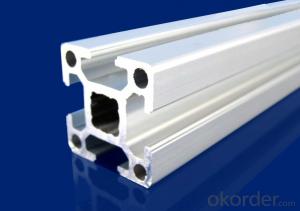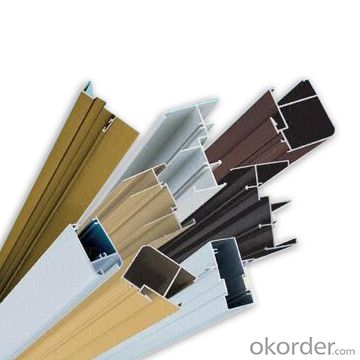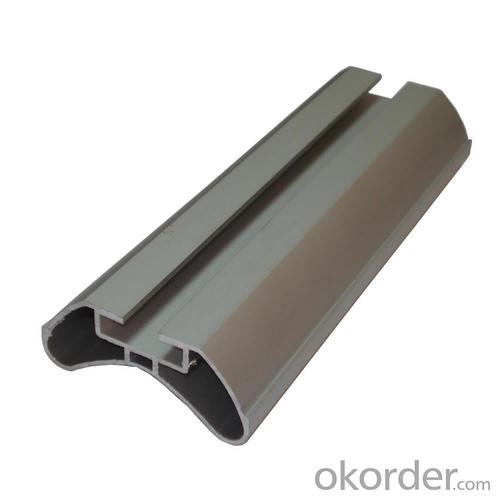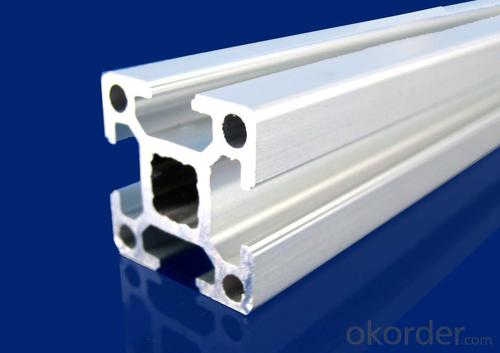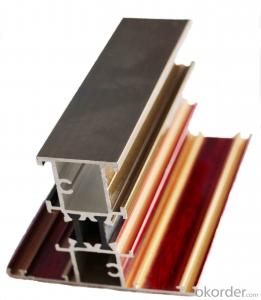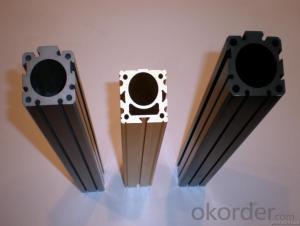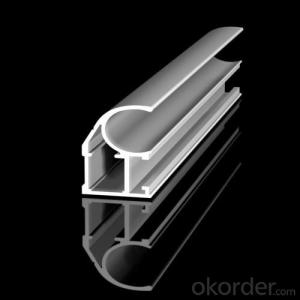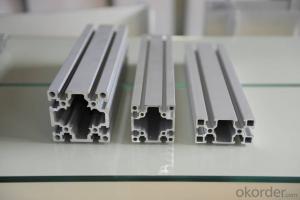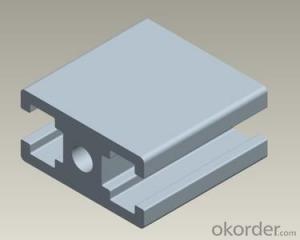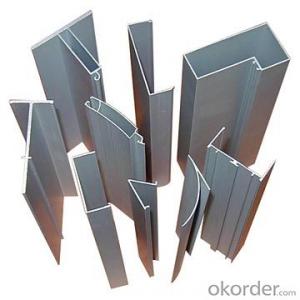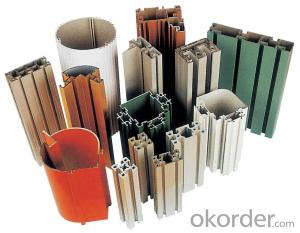Customized 6063 T5 Aluminum Extrusion Profiles H Channel
- Loading Port:
- China Main Port
- Payment Terms:
- TT OR LC
- Min Order Qty:
- -
- Supply Capability:
- -
OKorder Service Pledge
OKorder Financial Service
You Might Also Like
Aluminium is a relatively soft, durable, lightweight, ductileand malleablemetalwith appearance ranging from silvery to dull gray, depending on the surfaceroughness. It is nonmagnetic and does not easily ignite. A fresh film ofaluminium serves as a good reflector (approximately 92%) of visible lightand an excellent reflector (as much as 98%) of medium and far infraredradiation. The yield strength of pure aluminium is 7–11 MPa,while aluminium alloys have yield strengths ranging from200 MPa to 600 MPa. Aluminium has about one-third the densityand stiffness of steel. It is easily machined,cast, drawn and extruded.
Aluminium alloys (or aluminum alloys; see spellingdifferences) are alloysin which aluminium(Al) is the predominant metal. The typical alloying elements are copper, magnesium,manganese,silicon,tin and zinc. There are twoprincipal classifications, namely casting alloys and wrought alloys, both of which are furthersubdivided into the categories heat-treatableand non-heat-treatable. About 85% of aluminium is used for wrought products,for example rolled plate, foils and extrusions.Cast aluminium alloys yield cost-effective products due to the low meltingpoint, although they generally have lower tensile strengthsthan wrought alloys. The most important cast aluminium alloy system is Al–Si,where the high levels of silicon (4.0–13%) contribute to give good castingcharacteristics. Aluminium alloys are widely used in engineering structures andcomponents where light weight or corrosion resistance is required
Features:
Material | Alloy 6063,6061,6005or according to customer’s choice |
Temper | T3, T4, T5, T6 |
Surface | Anodize, electrophoresis, powder coating, PVDF coating, wood grain painting, matted, etc. |
Length | Coating 6.5 meters, Anodizing 6.5 meters, Mill finish 5 meters |
Application | Industrial, electrical equipment(TV set, air conditioner, refrigerator, computer), decoration,construction, transportation |
Custom Made | We can package following with customer's request. |
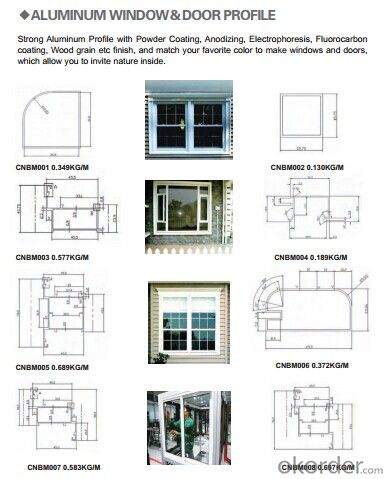
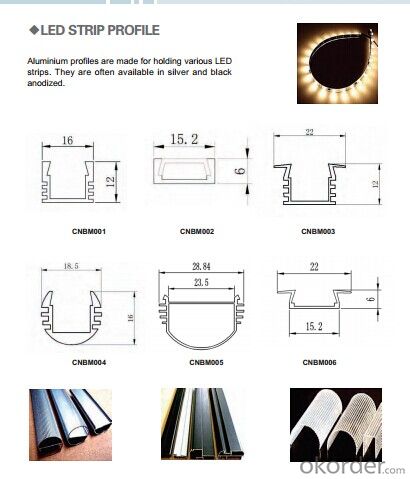
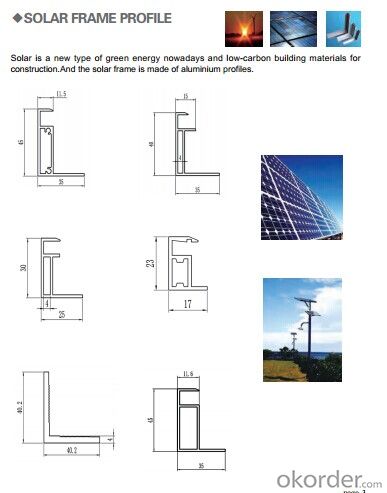
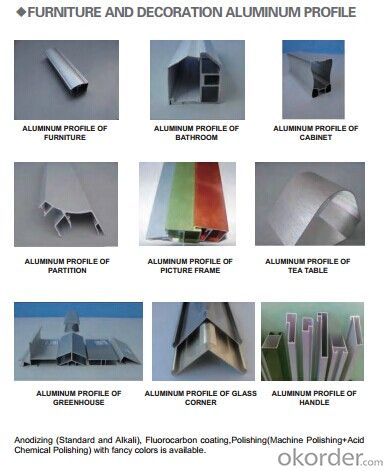
FAQ:
1. What is the form of payment?
Normally 30% TT, L/C at sight
2. Type of quotation?
FOB, CFR, CIF
3. Port of loading?
Shenzhen/Guangzhou port
4. Delivery time?
15-20 days after client’s deposit
- Q: What are the surface hardness properties of aluminum profiles?
- The surface hardness of aluminum profiles can differ depending on the specific alloy and treatment processes used. In comparison to metals like steel, aluminum alloys generally have lower hardness. However, by employing various treatments, aluminum profiles can achieve improved surface hardness. One commonly used treatment method is anodizing, which involves the creation of an oxide layer on the aluminum surface. Not only does this process enhance the corrosion resistance of the profiles, but it also increases their surface hardness. Depending on the thickness of the oxide layer, anodized aluminum profiles can have a hardness ranging from 150 to 300 HV (Vickers hardness). Another treatment process is hard coating, where a ceramic material like aluminum oxide is applied to the surface of the profiles. This coating drastically enhances the hardness of the aluminum, providing a higher level of wear resistance. The hardness of hard-coated aluminum profiles can range from 400 to 600 HV or even higher. It is important to note that the specific hardness properties can vary based on the alloy composition, surface treatment method, and intended application of the aluminum profiles. Hence, it is crucial to consult manufacturers or suppliers to determine the appropriate hardness properties that best suit your specific needs.
- Q: Can aluminum profiles be used in transportation and logistics applications?
- Aluminum profiles find common usage in transportation and logistics applications, owing to their lightweight yet robust nature. This makes them an ideal choice for various components in the industry. Within the automotive sector, aluminum profiles are employed in the production of car frames, chassis, and body panels. Their lightweight quality aids in reducing vehicle weight, leading to enhanced fuel efficiency and lower emissions. Moreover, aluminum profiles exhibit excellent resistance to corrosion, ensuring vehicle longevity even in harsh environmental conditions. The aerospace industry heavily relies on aluminum profiles for the construction of aircraft structures, including wings, fuselage, and landing gear. The high strength-to-weight ratio of these profiles allows for increased payload capacity and improved fuel efficiency. Furthermore, aluminum profiles can withstand extreme temperature fluctuations and possess good electrical conductivity, rendering them suitable for diverse aerospace applications. In the logistics sector, aluminum profiles are utilized in the creation of cargo containers, pallets, and storage racks. Their lightweight nature facilitates easy handling and transportation of goods. Additionally, these profiles offer high resistance to rust and corrosion, ensuring the durability of logistics equipment, even in humid or corrosive environments. Moreover, aluminum profiles can be easily customized and fabricated to meet specific design requirements in transportation and logistics applications. Their extrudability into various shapes and sizes allows for versatility in design and functionality. Furthermore, aluminum profiles offer flexibility in assembly and maintenance, as they can be joined using different methods like welding or fastening. To sum up, the lightweight, strong, corrosion-resistant, and versatile properties of aluminum profiles make them highly suitable for transportation and logistics applications. They confer various benefits, such as improved fuel efficiency, increased payload capacity, and durability in harsh environments. Consequently, aluminum profiles find extensive use in the automotive, aerospace, and logistics industries for various components, thereby contributing to the efficiency and reliability of transportation and logistics systems.
- Q: This question asks for methods to prevent corrosion on aluminum profiles during the installation process.
- <p>To prevent corrosion of aluminum profiles during installation, follow these steps: 1. Use stainless steel fasteners and avoid galvanized or carbon steel screws which can cause galvanic corrosion. 2. Keep the aluminum profiles clean and dry during installation to avoid contact with moisture which can initiate corrosion. 3. Apply a protective coating or sealant to the profiles, especially at cut edges where the protective oxide layer may be compromised. 4. Store aluminum profiles in a dry, cool place before installation to prevent moisture absorption. 5. Regularly inspect and maintain the profiles to identify and address any signs of corrosion early. By adhering to these practices, you can significantly reduce the risk of corrosion on aluminum profiles during installation.</p>
- Q: Can aluminum profiles be used in the production of laboratory equipment?
- Laboratory equipment manufacturing can utilize aluminum profiles effectively. Aluminum, being a versatile material, finds application in multiple industries, including the production of laboratory equipment. Aluminum profiles provide numerous benefits in this regard. To begin with, aluminum possesses a combination of lightweight and strength, making it an ideal choice for constructing portable or frequently movable equipment within laboratories. Its lightweight nature reduces the strain on laboratory personnel while handling and transporting the equipment. Moreover, aluminum profiles offer easy shaping and molding capabilities, enabling the customization of laboratory equipment to meet specific requirements. This design flexibility allows for the creation of equipment with complex shapes and structures, ensuring optimal functionality and efficiency. In addition, aluminum exhibits excellent corrosion resistance, a crucial property in laboratory settings where exposure to chemicals and liquids is common. This corrosion resistance extends the lifespan of the equipment and maintains its good condition even after prolonged use. Furthermore, aluminum profiles can be anodized or coated to provide additional protection against wear, scratches, and other forms of damage. This enhances the durability and facilitates easier cleaning, ensuring the maintenance of required hygiene standards in laboratories. Lastly, aluminum possesses high conductivity, making it suitable for applications that require heat transfer or electrical conductivity. This property proves advantageous for laboratory equipment, such as heating plates, heat sinks, or electrical circuit components. In conclusion, aluminum profiles are indeed suitable for the production of laboratory equipment. Their lightweight, malleable, corrosion-resistant, and conductive properties make them an excellent choice for manufacturing various types of laboratory equipment, guaranteeing durability, functionality, and ease of use.
- Q: What kind of self tapping screw can attack aluminum profile?
- According to the national standard of self tapping screw, all can, because the general self tapping screw is carburized layer, the surface will harden, attack aluminum and wood, plastic is not a problem. But now many of the things that are made in China are of poor quality. If you attack the aluminum material, it's better to use a little bit of screw
- Q: Explain the advantages of utilizing aluminum profiles in the construction industry.
- <p>Aluminum profiles offer several benefits in construction, including high strength-to-weight ratio, which means they are strong yet lightweight. This reduces the load on structures and facilitates easier handling and installation. They are also corrosion-resistant, ensuring longevity and low maintenance costs. Aluminum profiles are recyclable and environmentally friendly, contributing to sustainable construction practices. Their malleability allows for versatile design and customization, accommodating various architectural needs. Additionally, they have excellent thermal conductivity, which can be beneficial for heat management in buildings. Lastly, their aesthetic appeal and modern look enhance the visual appeal of construction projects.</p>
- Q: What are the different grades of aluminum used in profiles?
- Profiles commonly use various grades of aluminum, depending on desired characteristics and intended applications. Some commonly used grades include: 1. 6061-T6: This grade, widely utilized and versatile, offers excellent strength, corrosion resistance, and machinability. It suits structural components, frames, and automotive parts. 2. 6063-T5: Renowned for its excellent extrudability, this grade is popular in architectural applications like window and door frames. It provides good corrosion resistance and is easily surface-treated or anodized. 3. 6082-T6: Similar to 6061-T6 in strength and corrosion resistance, this grade is often preferred for applications requiring higher weldability. It finds use in the transportation industry, manufacturing truck and trailer components. 4. 7075-T6: Acknowledged for its exceptional strength and high stress resistance, this grade is common in aerospace applications, including aircraft structures and missile components, where strength and lightweight properties are crucial. 5. 3003-H14: This grade is primarily chosen for its outstanding formability and corrosion resistance. It is often used for decorative applications like trim or architectural accents. These examples highlight the range of aluminum grades used in profiles, each offering unique properties and advantages across various industries. Selecting the appropriate grade is vital to meet specific requirements and performance expectations when manufacturing profiles.
- Q: Are aluminum profiles suitable for signage and advertising displays?
- Signage and advertising displays can greatly benefit from the use of aluminum profiles. This material is lightweight and durable, making it resistant to corrosion and perfect for outdoor use. It can withstand various weather conditions without compromising its structural integrity, ensuring longevity and reliability for signage and advertising displays. Moreover, aluminum profiles offer a great deal of versatility in terms of design and customization. They can be easily shaped and molded into different forms and sizes, allowing for the creation of eye-catching and unique displays. In addition, aluminum profiles provide a sleek and modern appearance, giving a professional touch to any signage or advertising display. Furthermore, aluminum profiles are highly compatible with other commonly used materials in signage and advertising, such as acrylic, PVC, and LED lighting. This compatibility allows for the integration of different elements, including illumination, to enhance the visibility and impact of the displays. Additionally, aluminum profiles offer easy installation and maintenance. They can be easily assembled, disassembled, and reconfigured as needed. Their lightweight nature makes them easy to handle, reducing installation time and costs. Furthermore, aluminum profiles require minimal maintenance, as they are not prone to rust or deterioration. In conclusion, aluminum profiles are an excellent choice for signage and advertising displays. They provide durability, versatility, compatibility, and ease of installation and maintenance. Whether for outdoor or indoor applications, aluminum profiles can offer visually appealing and long-lasting solutions for effective signage and advertising.
- Q: The subject is aluminum bearing in what u ~ on both sides of the track?? How can the track be fitted into this slot? Both sides secure 50Mechanical expert answers!The subject is aluminum bearing in what u ~ on both sides of the track?? How can the track be fitted into this slot? How can the seat of fixed motor on both sides be connected with the section bar?
- A little understanding of machinery, not what you say master. Say, for reference only. No, please correct me.
- Q: Are aluminum profiles suitable for constructing energy-efficient building systems?
- <p>Yes, aluminum profiles can be used to create energy-efficient building systems. They are lightweight, strong, and have excellent thermal conductivity, which can be advantageous in heat transfer management. Aluminum profiles can be used in the construction of windows, doors, and facades, which are critical for insulation and energy conservation. Additionally, their malleability allows for precise engineering to minimize heat loss and maximize energy efficiency. Proper insulation and sealing techniques can further enhance the energy efficiency of buildings constructed with aluminum profiles.</p>
Send your message to us
Customized 6063 T5 Aluminum Extrusion Profiles H Channel
- Loading Port:
- China Main Port
- Payment Terms:
- TT OR LC
- Min Order Qty:
- -
- Supply Capability:
- -
OKorder Service Pledge
OKorder Financial Service
Similar products
Hot products
Hot Searches
Related keywords
